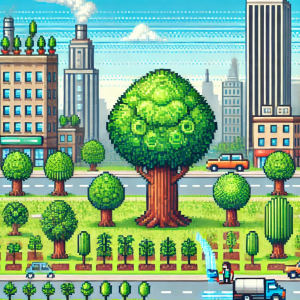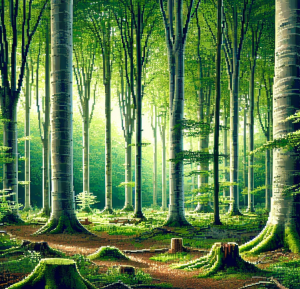
The Great Forest Slowdown: Why Trees Can’t Keep Up with Climate Change
What if I told you that tropical forests are in a high-stakes race against climate change—and they’re losing? Trees are shifting their ranges to escape rising temperatures, but the bad news? They’re moving at a glacial pace while climate change sprints ahead. And that could spell trouble for some of the world’s most diverse ecosystems.
Scientists studying forests from Mexico to Brazil have found that while some tree species are adapting to warmer, drier conditions, most are struggling to keep up. It turns out trees have one big problem: they can’t just pack up and move. Instead, they have to rely on slow growth, seed dispersal, and survival of the fittest. But what happens when even the fittest can’t adapt fast enough?
Trees Are Migrating—But Not Fast Enough
Think of climate change as a rising flood, and tropical trees as people trying to run to higher ground. Except in this case, the “people” are rooted in place, and their only hope is that their offspring can settle in better conditions before the flood overtakes them.
A recent study analyzed over 250,000 trees across 415 forest plots over the past 40 years. The scientists wanted to know: Are trees adapting their traits to match the rapidly changing climate? The answer? Kind of—but at a snail’s pace.
Lowland forests, which cover vast areas with relatively stable climates, are showing the most significant shifts. Deciduous species (trees that shed leaves to survive dry periods) are becoming more common, and leaves are getting smaller and tougher to cope with heat and drought. But here’s the kicker: these changes are happening at less than 8% of the speed necessary to keep up with climate change. In other words, the climate treadmill is set to sprint, but the trees are still stretching their legs.
The Forest’s Generation Gap
Not all trees are reacting to climate change the same way. Researchers categorized them into three groups:
- Survivors: Trees that made it through the past 40 years, adapting slowly to new conditions.
- Recruits: Young trees growing in the forests now, supposedly best suited to the current climate.
- Fatalities: Trees that couldn’t handle the change and died off.
If forests were adjusting perfectly to climate change, the recruit group should reflect the new climate reality. But even the recruits—nature’s fresh start—are adapting at only 22% of the expected rate. That’s like sending your fastest runner into a race, only to realize they’ve been training for the wrong event.
Even worse? Some recruits are developing traits that make them less suited for the warming climate, such as growing thinner leaves that lose more water. It’s like trees are trying to outrun climate change while wearing flip-flops.
The Unexpected Twist: Why Some Forests Lag Behind
One of the biggest surprises of this study was that montane forests (high-altitude forests) are shifting even slower than lowland forests. That’s weird because mountains offer an easy escape route—species just need to move upslope to cooler, wetter conditions. But that’s not happening as quickly as expected. Why?
- Growth Takes Time: Trees aren’t marathon runners; they’re more like long-distance hikers. It can take decades for a tree to grow and reproduce, meaning rapid shifts just aren’t in their DNA.
- Seed Dispersal Is a Mess: Many tropical trees rely on animals like birds and monkeys to spread their seeds. But with deforestation and habitat destruction, these animal couriers are disappearing.
- Climate Chaos: It’s not just about getting hotter. Changing rainfall patterns, soil nutrients, and extreme weather events create unpredictable environments that trees struggle to adjust to.
The Big Picture: What This Means for Forests (and Us)
If trees can’t adapt fast enough, what happens next? Scientists warn that tropical forests could become “out of sync” with their environment, leading to weaker ecosystems, more tree deaths, and even shifts in carbon storage. That’s a problem for everyone, because tropical forests play a massive role in absorbing carbon dioxide and regulating Earth’s climate.
These findings highlight a deeper issue: nature doesn’t have an emergency escape plan for climate change. If forests—some of the most resilient ecosystems on Earth—are struggling to keep up, imagine what this means for other species, including us.
The question now is: Can we help forests keep up? Scientists suggest that conservation efforts, seed banks, assisted migration (helping trees move to better locations), and reducing deforestation could make a difference. But we need action now—because unlike trees, we can move quickly.
Let’s Explore Together!
Now it’s your turn:
- What’s the coolest science fact you’ve learned recently?
- How do you think we can help forests adapt to climate change?
- If you could plant one tree species in your backyard to help the planet, what would it be?
Drop your thoughts in the comments or share this with a friend who loves nature. The more we understand, the better we can protect the forests we all rely on!
Explore and Learn
Now, more than ever, we need science to guide critical decisions. Dive into groundbreaking research and inspiring stories with This Week in Science! Perfect for teachers and science enthusiasts, our free weekly newsletter gives you the tools to expand your knowledge and fight misinformation. Act now—join today to make sure science has a louder voice in shaping our future. If you liked this blog, please share it—your referrals help us amplify science’s impact.



